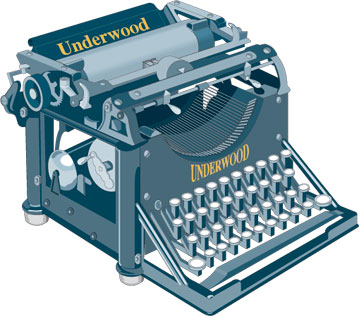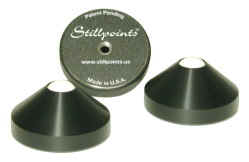You are reading the older HTML site
Positive Feedback ISSUE 5
february/march 2003

From Clark Johnsen's Diary: AUDIO DISCOVERY OF THE DECADE, ALREADY!
by Clark Johnsen
They call them tweaks. I call them, fine tuning aids.
But what does one properly call vibration isolation? The Vibraplane and subsequent devices demonstrated the need for isolation from that mean Mutha Earth for both turntables and CD mechanisms, and even for some other elements of a system. ("Even solid state is not that solid," I once wrote.) For years I have opined that the largest difference among turntables may well be their susceptibility to outside vibration, an assertion that still remains untested.
Also we have RFI/EMI fields all around us, some generated by the audio system itself. While no one I know has built a Faraday cage around his room, many designers do seek to account for these interferences by intelligent layout, shielding etc. And again, who knows but what many differences among pieces of gear may be due to these very benefits?
Now a new product appears on the market that bids fair to extinguish such differences. The name is ERS (Electromagnetic/Radio-frequency Suppression) and it makes the most amazing single (and easy) aural improvement across the board that I've ever encountered. Not only that, but you're reading about it here first.
Talk about positive feedback!
Appearances can be deceptive and ERS is no exception. It looks like nothing more than a sheet of gray construction paper until you hold it up to the light. Then you see particles of various sizes imbedded. These consist of mostly-metallic elements that absorb, reflect and diffuse RFI/EMI across the (manufacturer-specified spectrum) of 10MHz to 17GHz. But I know that it goes below that line.
Paul Wakeen and Larry Jacoby (of Stillpoints) are the gentlemen responsible. Stillpoints approached the manufacturer to create a broad-band material for audio/video circuitry. It took months to get the formula right. ERS is the happy result.
And thus made its first public appearance at the recent CES, although only to select exhibitors. I first heard it only on the third day of the show, but thereafter amused myself by astonishing friendly exhibitors with its effectiveness. All these episodes will be reported in my Diaries, to be published later, but two stories illustrate the reception accorded.
The Wisdom Audio speakers and demos have never impressed me. Not even their "Million Dollar System" last year. Especially not that! Always the sound was edgy, likely due to the exclusive CD sources, and magnified by the volume the speakers could produce. Not for my taste. I ventured into their room this year for the first time, an hour after acquiring a small supply of the ERS sheets (three, in fact). Well! They totally transformed the system. So impressed was everyone, I left the sheets while I went to lunch. Afterwards I was informed that they worked well on the loudspeaker boxes and the amps but the single best spot was on the CD player. Indeed. I was asked by one of the company investors (!) to leave a sheet, which I declined, but I did seize the opportunity for an experiment. Cutting one sheet in half, we placed it on the player, to equally good effect. After motioning the man up off the floor—by now he was on his knees begging—just kidding!—I was prevailed upon to leave that small portion.
This story illustrates two astonishing aspects of ERS. Its absorption seems more crucial than its reflection/diffusion capabilities, and less can be just as good (to a point, of course). These principles had been enunciated to me by Paul Wakeen, but here was confirmation. It should also be clear from this narrative, that whatever benefits might accrue from total shielding, have not yet been experienced by anyone. A whole new era may await.
Second story: Walking into Bobby Palkovic's Merlin room late on the last day, there was no one there and I finally had a chance to listen to what is often one of the best-sounding systems. And bad, it wasn't. Still, that CD edge... So when I brought out a couple sheets of ERS, Bobby's eyes bugged out and he whipped them out of my hand. "Someone was here earlier with these and I was amazed." Immediately the sound was fresher, purer, and seemingly unencumbered by digital artifacts. We all smiled and Bobby hauled out some brewskis. I stayed for half an hour, relaxing and enjoying the music.
Now I'm told that Merlin halted all production of loudspeakers until the ERS material could be retrofitted. Yes, it works on crossovers. And on drivers too, from what else I've heard.
Sheets, I say. But ERS is fabricated in yard-wide rolls. Use it for wallpaper—seriously! Also available in a variety of electrical characteristics, impregnancies, flammability, laminations, colors, lengths and pressure-sensitive adhesive backings. Oh and did I say? The stuff is not expensive. Not at all. One 8 x 11 sheet of PAS laminate is expected to retail for under $20. That twenty bucks will treat a whole lot of ills.
According to Paul, the manufacturing process, while not fully disclosed to him, seems entirely straightforward. Blends of carbon fibers are wash-coated with metals in a proprietary process, then introduced into the pulp of a rather standard paper-making machine. For the record, the currently available material is mildly flammable and highly conductive.
Friends, if what I say is true, we have a revolution on our hands—especially in digital, where not only are the devices susceptible to outside radiation, but they produce multi-MHz's of their own. Digital may be its own worst enemy!
As Paul says, "While different topologies still matter, the ERS allows a designer to start with a truly white sheet of paper."
Finally, I have also been playing with a product called Brilliant Pebbles, from Geoff Kait of Machina Dynamica. While similar claims are made about broadband RFI/EMI absorption, they seem to complement or supplement the ERS, besides having an effect on the whole room. Currently we are placing them in corners! Also they performed, um, brilliantly behind a pair of Pipedreams loudspeakers. Certainly makes one wonder.

STILLPOINTS
Woodville WI 54028
North American Sales TEL 866. 823. 8720
North American Sales [email protected]
Factory 715. 698. 3253
email address: [email protected]
web address: www.stillpoints.us

MACHINA DYNAMICA
Vibration Isolation & Resonance Control Solutions
2978 Yarling Ct.
Falls Church, VA 22042
TEL: 703. 560. 3018
web address: www.machinadynamica.com
